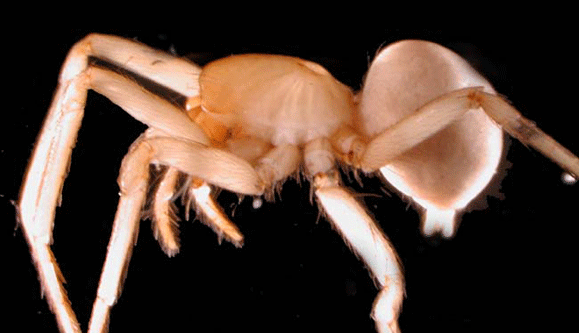
This research is funded by the U.S. Fish & Wildife Service and the La Cantera Development Company. Dr. Pierre Paquin, a postdoc in the lab, is the point-person on this project. Jean Krejca, James Cokendolpher, Kemble White and Tannika Engelhard have been very important in project development and specimen aquisition.
The karst regions of Texas are home to hundreds of ecologically specialized, geographically endemic cave-dwelling invertebrate animal species. Many of these species are restricted to life within the confines of a single cave. Because of this one-to-one relationship between a single habitat and a unique species, species persistence is often precarious.
To circumvent loss of Biodiversity, several Texas cave invertebrates have been listed as Federally Endangered Species. This designation provides a legal safeguard for these endemic species and their habitats. Moreover, because listed species are often biologically obscure, the endangered designation often provokes us to learn more about the systems of interest. Our genetic work is providing crucial additional biological information for two genera of Texas cave arachnids that include Federally listed species (the spider genus Cicurina and the opilionid genus Texella).
Endangered Cicurina and Texella are obscure cave arachnids – we simply don’t know very much about the biology of these animals. A particularly daunting constraint in both genera is the rarity of adult specimens in cave habitats. Accurate species identification in both Cicurina and Texella requires adult specimens, as this is the only life stage in which the morphological characters used to identify species (genitalia) are expressed. Immature specimens, although readily keyed to genus, cannot be identified with confidence to species. This rarity of adult animals has two very important implications:
- A lack of identifiable adults compromises our knowledge of the invertebrate community in any particular cave habitat. For example, many Texas caves are known to house cave obligate Cicurina or Texella (i.e., eyeless immatures of these genera have been collected), but the lack of adult specimens prevents us from knowing which Cicurina or Texella species is represented. Are the immatures members of a protected species or not? Of course, being able to answer this most basic of questions is crucial to the management of habitats.
- A lack of identifiable adults compromises our knowledge of the geographic distribution of taxa, including endangered species. This is particularly true for species that are apparently endemic to one or a few locations, as are many endangered cave taxa. For example, several of the Texella or Cicurina species that are apparently restricted to a single cave (i.e., adults have only been collected at that site) might also occur in geographically adjacent caves that house unidentifiable immatures. Again, this basic biological information is crucial to the effective management of species.
We are using genetic evidence to assess species identity in TX cave-dwelling Cicurina and Texella. Unlike certain aspects of external morphology (e.g., genitalia), most “DNA phenotypes” are expressed throughout the lifespan of an individual. This means that genetic characters that diagnose a species can be assayed in members of that species regardless of lifestage. Such genetic assessment relies upon a three-part foundation: 1) designing a sampling strategy that provides an adequate context for accurate DNA-based identification, 2) obtaining specimens consistent with this sampling strategy, and 3) using DNA markers to assess identity of undetermined specimens.